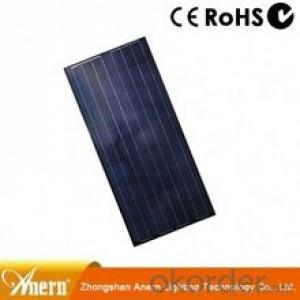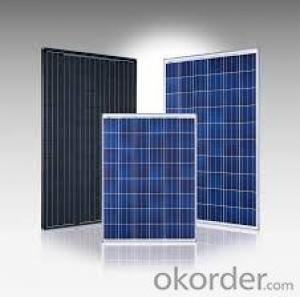High Efficiency 295W Monocrystalline Solar Cell Price with 25 Year Warranty CNBM
- Loading Port:
- Qingdao
- Payment Terms:
- TT OR LC
- Min Order Qty:
- 10 set
- Supply Capability:
- 300000 set/month
OKorder Service Pledge
OKorder Financial Service
You Might Also Like
High Efficiency 295W monocrystalline solar cell price with 25 year warranty
Quick Details
| Place of Origin: | China (Mainland) | Brand Name: | cnbm | Model Number: | PS-M672300 |
| Material: | Monocrystalline Silicon | Size: | 1956*990*40mm | Number of Cells: | 72 pieces |
| Max. Power: | 300W | Weight: | 23kg monocrystalline solar panel | Product warranty: | 25 years |
| Maximum system voltage: | 1000VDC | Tolerance: | 0/+3% | Cable length: | 1.2m |
| Connector: | MC4 compatible connector | Junction box: | IP65 Rated | Frame: | Anodized aluminium alloy |
| Front Cover: | 3.2mm thick.low iron tempered glass | Cell type: | Monocrystalline solar panel cells 156mm |
Packaging & Delivery
| Packaging Detail: | Monocrystalline solar panel packing information 28pcs. / box 20pcs. / pallet 560 pcs. / 40ft 602 pcs. / 40ft (H) |
| Delivery Detail: | in one week |
Specifications
1. Best monocrystalline solar cell price
2. 300W Monocrystalline solar panel with best price
3. 25 years warranty
Product Name
High Efficiency monocrystalline solar cell price with 25 year warranty
Product Description
1.Solar Panel Descprition
PS-M672 Series solar panel is connected in series by 70 pieces of 156mm×156mm Mono Crystalline silicon cells. Solar panel performance is produced according to IEC61215, IEC61730 international standard.
2.Solar Panel Characteristics
1)Manufactured according to international quality and Environment Management
System (ISO9001, ISO14001)
2)High efficiency crystalline silicon solar cells
3)High transmission Iow iron tempered glass, strong mechanical resistance
4)Anti-ageing EVA and excellent anti-climate back sheet
5)Anodized aluminum frame improves load resistance capabilities for heavy wind loads.
6)Standard waterproof junction box
7)High endurance to different weather
8)Good and friendly package with less transportation and storage space.
3.Solar Panel Warranty
1)10 years limited manufacturing warranty
2)10 years for 90% of warranted minimum power
3)25 years for 80% of warranted minimum power
4.Solar Panel Electric Characteristics
| Cell Type | Mono Solar Cell 156mm*156mm | |||
| Item | PS-M672285 | PS-M672290 | PS-M672295 | PS-M672300 |
| Power | 285W | 290W | 295W | 300W |
| Voc(V) | 44.8 | 45 | 45.3 | 345.5 |
| Isc(I) | 8.6 | 8.75 | 8.85 | 8.95 |
| Vm(V) | 36.2 | 36.3 | 36.5 | 36.6 |
| Im(I) | 7.87 | 7.99 | 8.08 | 8.20 |
| Cell Efficiency | 17.08 | 17.38 | 17.68 | 17.98 |
| Module Efficiency | 14.72 | 14.98 | 15.23 | 15.49 |
| Fuse | 15A | |||
| Max System Voltage | 1000VDC | |||
| Cell Number | 72cells | |||
| Tolerance | 0/+3% | |||
| dule Size | 1956*990*40(mm) | |||
| Weight | 23KGS | |||
| Cable Length | 0.9m | |||
| Connector | MC4 or compatible connector | |||
Global Projects
20MW Solar Power Plant in China
130KW Solar Power Plant in Japan
700KW Solar Power Plant in Japan
- Q:Are solar cells impacted by shading?
- Yes, solar cells are significantly impacted by shading. When a solar cell is partially shaded, even with a small amount of shading, it can cause a considerable reduction in the overall energy output of the solar panel. This is because shading interrupts the flow of sunlight to the cells, leading to a decrease in their efficiency and power generation capacity. Therefore, it is important to ensure that solar panels are installed in unshaded areas to maximize their performance.
- Q:How about the current market price for the film solar?
- The price of film solar varies based on the quality and quantity. The expensive one could be RMN 150 each, while the cheaper on could be only RMB 25 each.
- Q:Can solar cells be used for desalination purposes?
- Yes, solar cells can be used for desalination purposes. Solar-powered desalination systems use solar energy to power the desalination process, typically through reverse osmosis or solar stills. This sustainable and renewable energy source can effectively convert seawater into freshwater, making it a viable solution for regions facing water scarcity.
- Q:How many types of solar cells are now being used in real life?
- 3 kinds of solar cells, Silicon-based, organic, chemical.
- Q:How do solar cells impact local economies?
- Solar cells can have a positive impact on local economies in several ways. Firstly, the installation and maintenance of solar energy systems create job opportunities, contributing to local employment rates. Additionally, solar energy reduces the dependence on fossil fuels, which can lead to a decrease in energy costs for businesses and households, thereby stimulating economic growth. Moreover, the use of solar cells promotes energy independence, reducing the need for importing energy and keeping money within the local economy. Overall, solar cells can foster job creation, cost savings, and energy autonomy, all of which contribute to a stronger and more sustainable local economy.
- Q:Are there any health risks associated with solar cells?
- There are no direct health risks associated with solar cells themselves. However, the manufacturing process of solar cells involves the use of certain chemicals and materials that can be harmful if not handled properly. Additionally, improper installation or maintenance of solar panels can pose electrical and fire hazards. Thus, it is important to ensure proper safety measures are followed during production, installation, and maintenance to minimize any potential health risks.
- Q:What is the maximum efficiency that a solar cell can achieve?
- The maximum efficiency that a solar cell can achieve is known as the Shockley-Queisser limit, which is approximately 33.7%. However, in practical applications, the efficiency of commercial solar cells typically ranges between 15-22%.
- Q:What factors affect the efficiency of solar cells?
- Several factors can affect the efficiency of solar cells, including the composition and quality of the materials used, the amount and angle of sunlight received, the temperature, and any shading or obstructions. Additionally, the design and manufacturing process of the solar cells, as well as the overall system configuration and maintenance, can also impact their efficiency.
- Q:What is the impact of solar cells on reducing water usage?
- Solar cells have a positive impact on reducing water usage because they generate electricity without needing water for cooling or steam production, unlike traditional power plants. This reduces the strain on water resources and helps conserve water for other important uses.
- Q:How can solar cells be used in residential applications?
- Solar cells can be used in residential applications by converting sunlight into electricity to power various household appliances and devices. They can be installed on rooftops or mounted on the ground to capture sunlight. The generated electricity can be used directly in the house or stored in batteries for later use. This renewable energy source reduces reliance on traditional fossil fuels, lowers energy bills, and contributes to a more sustainable and environmentally friendly home.
1. Manufacturer Overview |
|
|---|---|
| Location | |
| Year Established | |
| Annual Output Value | |
| Main Markets | |
| Company Certifications | |
2. Manufacturer Certificates |
|
|---|---|
| a) Certification Name | |
| Range | |
| Reference | |
| Validity Period | |
3. Manufacturer Capability |
|
|---|---|
| a)Trade Capacity | |
| Nearest Port | |
| Export Percentage | |
| No.of Employees in Trade Department | |
| Language Spoken: | |
| b)Factory Information | |
| Factory Size: | |
| No. of Production Lines | |
| Contract Manufacturing | |
| Product Price Range | |
Send your message to us
High Efficiency 295W Monocrystalline Solar Cell Price with 25 Year Warranty CNBM
- Loading Port:
- Qingdao
- Payment Terms:
- TT OR LC
- Min Order Qty:
- 10 set
- Supply Capability:
- 300000 set/month
OKorder Service Pledge
OKorder Financial Service
Similar products
New products
Hot products
Hot Searches
Related keywords



























